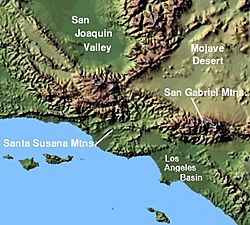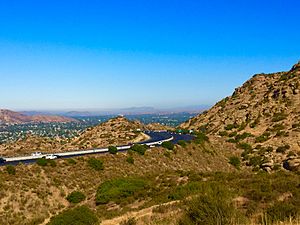Santa Susana, California facts for kids
Quick facts for kids
Santa Susana, California
|
|
|---|---|
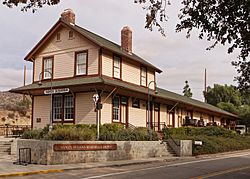
|
|
| Country | United States |
| State | California |
| County | Ventura |
| Area | |
| • Total | 1.113 sq mi (2.883 km2) |
| • Land | 1.113 sq mi (2.883 km2) |
| • Water | 0 sq mi (0 km2) 0% |
| Elevation | 1,165 ft (355 m) |
| Population
(2010)
|
|
| • Total | 1,037 |
| • Density | 931.7/sq mi (359.69/km2) |
| Time zone | UTC-8 (Pacific (PST)) |
| • Summer (DST) | UTC-7 (PDT) |
| GNIS feature ID | 2585445 |
Santa Susana (which means "St. Susan" in Spanish) is a community that used to be a railroad town. Most of it is now part of the city of Simi Valley. A small part of Santa Susana is still an unincorporated area, meaning it's not officially part of a city. This area is called a census-designated place (CDP) and is located in the eastern part of the Simi Valley.
The town of Santa Susana was started in 1903. This happened soon after the Southern Pacific Company built the Santa Susana Depot. Sometimes, the name is spelled Santa Susanna with two "n"s. Today, people often call the unincorporated part the Santa Susana Knolls or Simi Knolls. The name Santa Susana now refers to a larger area at the very east end of the Simi Valley. The historic Santa Susana Depot was moved and is now a museum. In 2010, the population of the Santa Susana CDP was 1,037 people. It's a quiet, rural area with unique homes, located in a hilly and somewhat forested part of the valley.
Long ago, the Chumash Indians lived here, as early as 500 AD. Many Chumash artifacts and rock paintings have been found in the area, including at Burro Flats Painted Cave. In the 1950s and 1960s, the Corriganville Movie Ranch and other spots in Santa Susana were used as movie sets for many Western movies. Famous films and TV shows like Gunsmoke, Bonanza, The Lone Ranger, and Star Trek were filmed here.
Santa Susana is also home to lots of native wildlife. You can find snakes, coyotes, hawks, and mountain lions living in the area.
Contents
What's in a Name?
The name "Santa Susana" comes from the Roman Empire. It's linked to the Santa Susanna Church in Rome, built in the 4th century. This church was named after Saint Susanna, a Roman Catholic saint who died in Rome in the 3rd century. The name has been used for many places since then, including a town in Spain and the Santa Susana Mountains in Southern California. The town of Santa Susana is named after these mountains. The area has also been called Green Haven and Mortimer Park in the past.
Santa Susana's Past
Ancient History of the Land
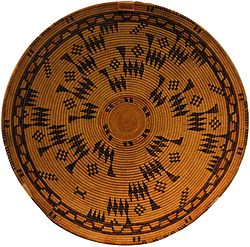
The hills and lower parts of the Santa Susana Mountains have been lived in for thousands of years. We know this because Chumash artifacts have been found near the Santa Susana Depot. There are also Chumash rock paintings from about 500 AD in the Burro Flats Painted Cave. It's possible that Native American people lived here as far back as 8,000 to 12,000 years ago. The Burro Flats Painted Cave was a special place for a winter solstice ceremony for the Ventureño Chumash people. The Chumash of Santa Susana traded with other groups like the Tataviam people and the Gabrielino people.
How the Town Grew
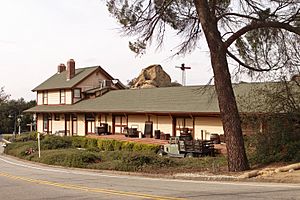
In 1887, a company called Simi Valley Land and Water Company started to plan out the area to sell land for ranches. The town of Santa Susana officially began in 1903 when the Southern Pacific Company built the Santa Susana Depot. Before this train station, people in Simi Valley had to travel all the way to San Fernando to catch a train. The first stores opened around the new train station, which helped the town grow. In 1910, oil was discovered nearby, bringing more people to Santa Susana. The first store was a general store opened in 1909 by Horace Crinklaw and his wife. By 1914, the town had eight buildings, including a schoolhouse and a blacksmith shop.
Santa Susana quickly became known as a place to film Western movies. Its rugged hills and unique rock formations were perfect for movie sets. Films were being shot on the main street of Santa Susana as early as 1920.
In the late 1930s, the Santa Susana Airport started as a simple dirt landing strip. It later became a paved airport for many planes in the 1970s. From the 1930s to the 1940s, the Corriganville Movie Ranch was a popular Western movie set. Hundreds of Western films and TV shows were filmed there, such as Jungle Jim, Lawman, and Adventures of Superman. In 1949, the ranch became a tourist attraction, drawing thousands of visitors. It was even called one of the "10 most interesting places in America."
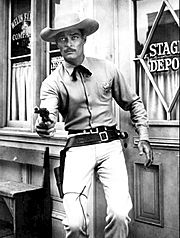
In July 1959, there was a serious event at the Santa Susana Field Laboratory. This event was a significant nuclear incident in American history. It was kept quiet for over twenty years until students from UCLA revealed it in the LA Times.
In 1969, people voted for Santa Susana to become part of the City of Simi Valley. So, on October 10, 1969, most of Santa Susana joined the city. The part of Santa Susana that is still unincorporated is known as the Santa Susana Knolls. This area is hilly, rural, and includes the Santa Susana Field Laboratory, which was used for rocket engine and nuclear reactor research.
Where is Santa Susana?
Santa Susana is located against the northern side of the Simi Hills and around the Santa Susana Mountains. Its average height is about 1,165 feet (355 meters) above sea level. It's a hilly and mountainous area with trees and unique sand rock formations. The community is in the easternmost part of the Simi Valley and Ventura County.
According to the United States Census Bureau, the CDP (the unincorporated part) covers about 1.1 square miles (2.9 square kilometers) of land. The northern border of the CDP follows the Metrolink train line. On the other side of the tracks is the city of Simi Valley.
There are many open-space nature areas near Santa Susana and in the northern Santa Susana Mountains. These include Rocky Peak, Santa Susana Pass State Historic Park, Sage Ranch Park, and Corriganville Park. These parks offer beautiful places to explore nature.
Who Lives in Santa Susana?
The 2010 United States Census showed that the CDP part of Santa Susana had a population of 1,037 people. Most of the people living there were White (87.2%). About 15% of the population identified as Hispanic or Latino.
There were 405 households in Santa Susana. About 27.4% of these households had children under 18 living in them. The average household had 2.55 people. The population was spread out in terms of age, with 17.9% of people under 18 and 9.1% who were 65 or older. The average age was 44.4 years. Most homes (75.8%) were owned by the people living in them, while 24.2% were rented.
Cool Places to Visit

Santa Susana has several interesting landmarks:
- Grandma Prisbrey's Bottle Village: This is a unique art environment made from thousands of bottles and other recycled materials. It's a California State Historic Landmark.
- Old Santa Susana Stage Road: This historic road was once used by stagecoaches.
- Santa Susana Depot: The old train station, now a museum.
- Corriganville Movie Ranch: A regional park that used to be a famous movie set.
- Santa Susana Pass State Historic Park: A state park with hiking trails and historical significance.
- Rocky Peak: A prominent peak in the Santa Susana Mountains, popular for hiking.
Amazing Wildlife
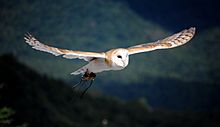
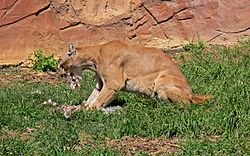
Santa Susana is next to the Santa Susana Pass wildlife corridor. This is like a natural bridge that connects different mountain ranges, allowing animals to move safely between them. The area is full of wildlife, including large mammals like mountain lions, coyotes, bobcats, and grey foxes. You can also find Virginia opossums, raccoons, and ring-tailed cats.
Many undeveloped areas here are protected as wildlife habitats. The dry climate of Santa Susana is perfect for many species that are used to hot and dry conditions. There are many reptiles, including eleven types of snakes:
- Coachwhip
- Southern Pacific rattlesnake
- San Diego night snake
- Striped racer
- California black-headed snake
- Two-striped garter snake
- San Diego gopher snake
- Coast mountain kingsnake
- California kingsnake
- Coast patch-nosed snake
- Ringneck snake
Lizards are also common, such as the San Diego horned lizard, California horned lizard, San Diego alligator lizard, western fence lizard, California side blotched lizard, western skink, western whiptail, and silvery legless lizard.
Birds of prey, also known as raptors, are often seen flying overhead. These include the California vulture, turkey vulture, white-tailed kite, American kestrel, Cooper's hawk, sharp-shinned hawk, marsh hawk, red-tailed hawk, red-shouldered hawk, and the common nighthawk. Several types of owls live here too, like the great horned owl, short-eared owl, long-eared owl, barn owl, and the burrowing owl. You might even spot peacocks and other interesting animals in this area. Scorpions are also common.
See also
 In Spanish: Santa Susana (California) para niños
In Spanish: Santa Susana (California) para niños



